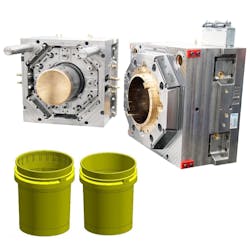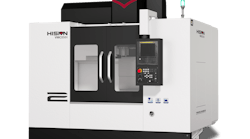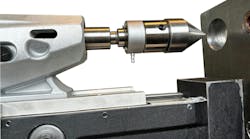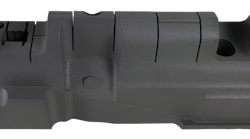By Karen Hanna
When it comes to conserving resin, StackTeck is cleaning up with its proprietary TRIM injection mold technologies, which it has continued to improve for the production of thin, yet strong 5-gallon buckets.
The Canadian company recently released the latest results of compression and drop testing, comparing conventional HDPE buckets with those made using its specialized molds for Thin Recess Injection Molding (TRIM). As part of a webinar offered in December to prospective customers, it also touted its KoolTrack suite of mold-cooling alloys and technologies, as well as automation offerings.
Company engineering director Jeff Ngai told participants the company’s TRIM molds can produce pails with wall sections that are just 0.059 inch thick, alternating with sections that measure 0.09 inch — the thickness of pails made with conventional molds.
“We selectively thinned out portions of the side wall to reduce the weight while trying to keep structural integrity. So, we were able to get the part down to 817 grams,” Ngai said. For comparison, the company’s conventional buckets with uniform, smooth walls weighed 930 grams.
Using its proprietary KoolTrack steel alloy as part of molds for both the TRIM pails and conventional pails, StackTeck significantly reduced cooling times, allowing its presses to produce the parts in 13-second cycle times. Typically, conventional pails require 16- to 18-second cycles, Ngai said.
To release the TRIM pails after molding, Jordan Robertson, VP of business development and marketing of StackTeck, explained that StackTeck has incorporated collets at the 12, 3, 6 and 9 o’clock positions on the mold along the rim of the pail.
Both TRIM and non-TRIM bucket styles passed drop and compression tests, Ngai said. The TRIM version survived an angled drop from an industry-standard height of about 5.9 feet, while the conventional pail handled about 6.9 feet. In compression testing, the TRIM pail withstood 820 pounds, and the standard pail tolerated more than 1,100 pounds. The industry standard is 352 pounds, he said.
“Both of them were significantly stronger than the minimum requirement,” he said.
Robertson said the company must weigh possible savings from material against the potential loss of part strength when it builds TRIM molds. He acknowledged that, whether it’s a case of appearance or performance, sometimes, lightweighting can go beyond the pail.
“We have experience where we’ve used extreme ultra-lightweight technologies in the past where we’ve taken out a huge amount of weight … and then made sample yogurt cups that were hardly as strong as a really thin paper cup, and we could see we really had gone too far,” Robertson said. “Our customers would handle these cups and squeeze them and say, ‘That’s interesting, but it’s kind of a different thing than what I do with my business.’ “
The trick is balancing cost savings with customers’ expectations for how much abuse a product should be able to take.
“There are samples where we’ve lightweighted as much as 40 percent by weight, but we’ve learned, through having applied the technology to a significant number of projects now, we’ve learned that there’s kind of a sweet spot that’s somewhere between 10 and 20 percent,” Robertson said.
According to Ngai, the company offers a variety of pail-mold options, including adjustable wedge locks, adjustable square collets and interchangeable bail lugs. Customers also can opt to use copper alloys in the molds.
“We wanted to show that we can do the higher-end options,” he said.
Increasing automation options
The company also continues to expand its robot offerings, Robertson said.
For the first time, it is offering a robot for in-mold labeling (IML) of pails. Configured for both a single-cavity 5-gallon pail and a two-cavity mold for 5-liter pails, the robot has typical intrusion times ranging from 1.5 seconds to 2.5 seconds, depending on the size of the part.
The new robot is designed so that swapping out mandrels and magazines, from a one-cavity setup to a two-cavity setup, takes just an hour.
Robertson said the company hopes to eventually offer the system through FastTrack, a program it created in spring 2019. IML robots offered through FastTrack can be shipped within 12 weeks, but currently only smaller units, such as those for food packaging and lids, are available.
“These robots are built with a modular approach where you can take a frame … the frame is common for machines in the size range from 300 tons to 600 tons,” Robertson said.
The company, which has custom-designed robots for larger machines, also is developing a unit for presses ranging from 200 tons to 400 tons. It can provide IML and takeout robots for its own molds, as well as for new and existing molds provided by other companies.
In addition, the company can make robots for machines of other sizes on a custom basis.
“We’re all about whatever the customer wants,” Robertson said.
Contact:
StackTeck Ltd., Brampton, Ontario, 416-749-1698, https://stackteck.com







